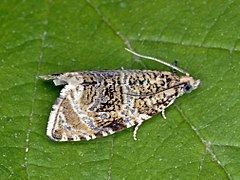Rank Species | Division Ditrysia Tribe Olethreutini Higher classification Syricoris | |
 | ||
Similar Celypha, Celypha striana, Butterflies and moths, Tortricidae, Agapeta hamana | ||
Syricoris lacunana, the dark strawberry tortrix, is a small moth species of the family Tortricidae. It is found in the Palearctic ecozone.
Contents
Like its congeners, it is sometimes still placed in the genus Celypha.
Synonyms
Junior synonyms of this species are:
Description
Syricoris lacunana has a wingspan of 16–18 millimetres (0.63–0.71 in). The forewings show various shades of gray brown crossed by a few thin irregular silvery lines. The caterpillars can reach a length of about 15 millimetres (0.59 in) and are colored brown to dark brown.
These moths are quite variable and can be confused with some other species (Olethreutes obsoletana, Celypha doubledayana, Orthotaenia undulana).
Biology
The adult moths are active at dusk and fly from late April to September in the temperate part of their range (e.g. Belgium and the Netherlands). The caterpillars can be encountered from April to September.
It is an univoltine species. The larvae are polyphagous, feeding on various herbaceous plants (Daucus spec., Succisa spec., Ononis sp., Mentha sp., Caltha sp., Ranunculus sp., Inula sp., Cirsium sp., Chrysanthemum sp., Lysimachia sp., Chenopodium sp.. Urtica sp., Artemisia sp., Filipendula spec., Fragaria sp., Sanguisorba sp., Epilobium sp., Rubus sp., Salix sp., Betula sp., Ligustrum sp.. Larix spec., Picea sp.).
Distribution
It is present all over Europe, including the most northern countries, in the east Palearctic ecozone and in the Near East.
Habitat
This very common species can be found in hedgerows, fields and woodland edges.
